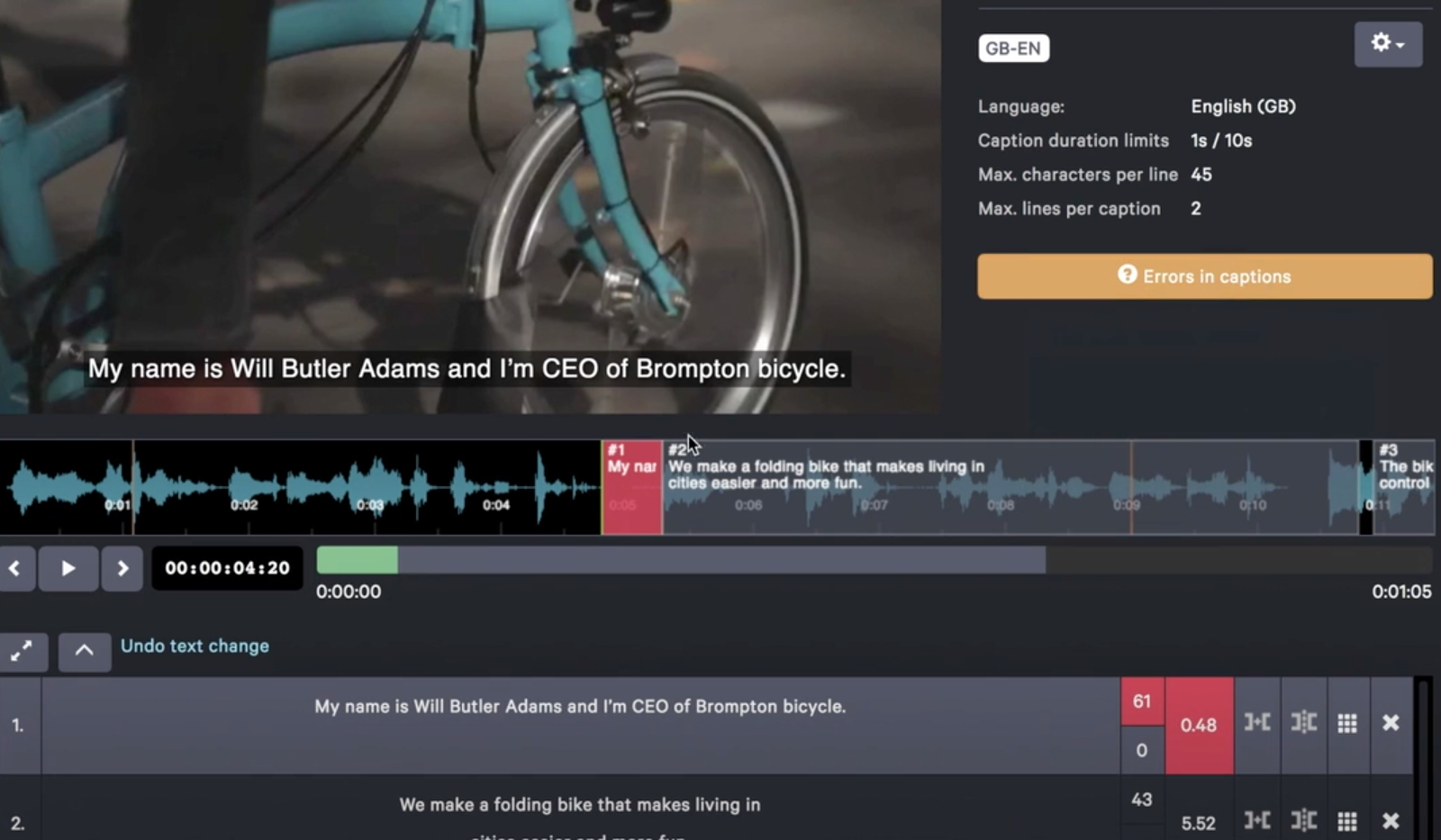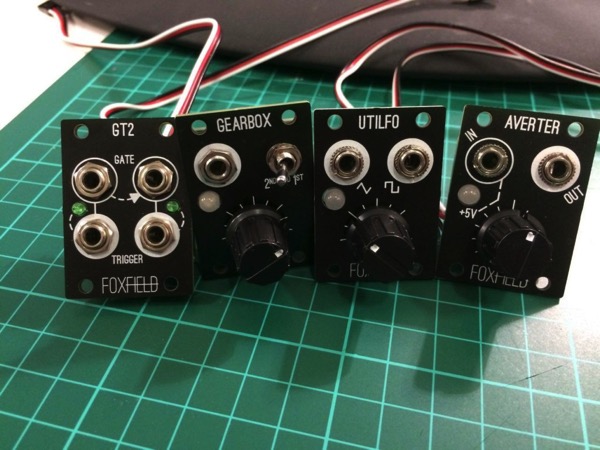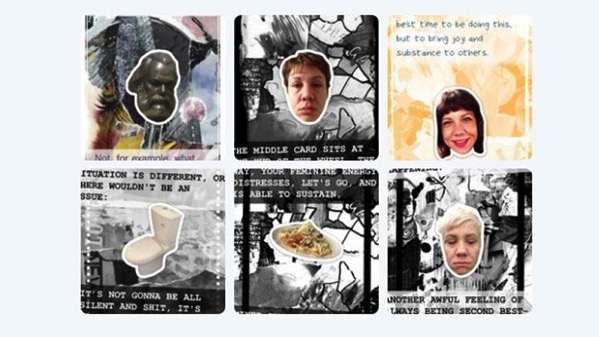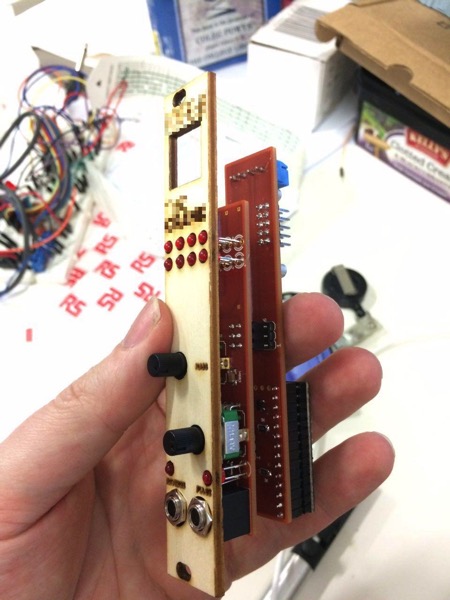Posts tagged as holmfell
Latest work case studies, summer 2019 edition
11 July 2019The case studies on this website were getting a little stale. No more! I’ve just published lots of new case studies of individual projects over the past three years.

The big headline that I’m most keen to talk about is a long, detailed writeup of my work on CaptionHub - a project I worked on for 3.5 years, known in this feed as Selworthy. CaptionHub is an online tool for collaboratively captioning and subtitling video. I served as technical lead and pathfinder, taking the initial idea - the “what if?” - to a prototype and beyond into a shipping product, whilst the team grew and the product acquired clients. The write-up is detailed not just because of the length time I worked on the project, but because of the way the product changed as it developed and grew in scale. It’s a project that shows the breadth of my capabilities well, and the finished product is something I’m very proud of.
But there’s lots more in there too. Highlights include: an open source tool for musicians; teaching on the Hyper Island MA; building a digital musicbox; creating a Twitter bot for an installation at the Wellcome Collection.
The write-ups all include extended thought on process, and, of course, link back to the relevant weeknotes that I wrote during the process.
You can find out more at the updated projects list.
I’m currently looking for new projects to work on: technical leadership, early stage exploration, communication of ideas, are all areas I’m keen to continue in. Topic areas I’m particularly interested in include building tools for creatives and professionals, the bridge between the physical and digital, and audio and video. I’ve written more about my capabilities here.
Weeks 298-305
29 October 2018Lots of time without weeknotes. Oops. But: lots has been going on.
Notably, Lambrigg wrapped up. The final weeks weren’t too crunchy, thankfully: just somesome busy, intense days to get to the finish line. In the final week we designed and wrote a new demo, re-coded both demos so that they could be more easily shared with colleagues, finalised two hardware prototypes, wrote our report and presentation deck, and got the whole thing into a shippable state. Phew.
It’s been a really nice shape of project. A research and development piece beginning – about three months ago – with background research, interviews, design reporting, a bit of strategy, and helping colleagues in the management team develop strategy further. Then, we moved into prototyping some preferred approaches in a manner that could be taken further if needed.
Across the project, I’ve conducted research interviews, done desk research into design and technology, explored possible technical approaches, designed some game prototypes, built software and firmware in Python, Ruby, Java/Processing, and C++. I’ve designed, fabricated and built up two different custom circuit boards that interface with one another, and built end-to-end prototypes that interface with a computer. I’ve produced CAD models for those boards for Tim to design around. By the end, we had turned all that into coherent physical prototypes with working demos.
That feels like a lot. Meaty work.
And then, I promptly got ill with endoftermitis: the come-down after pushing perhaps a wee bit hard. So I was off for a bit, and I think that threw my weeknotes muscle.
Since then, I’ve been working on a few things.
Firstly, decommissioning Holmfell – Erica Scourti’s _Empathy Deck_ – now that the Twitter API no longer supports, well, doing anything fun. We’ve said goodbye, and now we’re working out how best to properly archive a web project. That’s entailed not just taking dumps, but writing documentation for future users on what they are and how to interact with them. For instance, I’ve been turning some of the most significant Postgres tables into CSV – after all, as I say a lot, Excel is the prototyping tool everybody has on their desk, so it’s good to leave things in a state that doesn’t require me.
It also turns out the project generated around 17gb of images in its lifespan, so I’ve been trying to archive that in the most space- and time-efficient way possible. Unsurprisingly, it turns out that a little rsync goes a long way.
Over on Selworthy, we’ve been thinking a bit about infrastructure and operations, and choosing our next focus for incremental, ongoing improvement. I’ve also been prototyping some new interactions, which are going to be much easier to integrate with the existing front-end after the overhaul the team made to our front-end stack more recently.
I’ve started the work around preparing for this year’s Hyper Island Digital Technologies module. This year, it’s more of an incremental overhaul on last year, but it’s been good to start thinking about the structure and narrative of the module up-front. There’ll be more work on that in the weeks to come!
I’ve started conversations about a small R&D project called Sharphaw, which ties together some of my experience and expertise to help a company explore taking the objects they make and connecting them to internet services – a bit of IOT prototyping, a bit of thinking about service design, and fabricating a few things.
And, over on the music technology side: a small production run of kits for Thonk, and wrapping up an open-source community project I’ve been working on for a good while. I’m hoping to release that in week 306!
Phew. That’s a lot. Let’s try to do this more often.
Week 234-235
23 June 2017Some small news, and then the big news.
Over on Selworthy, I continued to work on wrangling ffmpeg and some arithmetic that’s going to to be part of a bit of an overhaul. Looking back on commits, progress feels slower than earlier. That’s because I’m doing a lot of measuring-twice before the cutting-once of a fairly sizeable change to some of the key underlying assumptions of the product. At the end of that work, very little will have changed on the surface – but the little that has will be a key improvement. It goes beyond what I’d call a refactoring given its scope and scale. But that’s my main focus there.
On Wapley, I spent a little time with Richard running simultaneous demos on a variety of devices whilst on a Skype chat to confirm and debug some issues. We managed to break the back of a few things that were causing issues and I think that work is all good to go.
Empathy Deck got a quick refresh with some new content and graphics work from Erica, and was redeployed into the world.
And Longcrag launched.

Longcrag has been the codename for Foxfield Instruments, a small imprint I’ve set up to sell electronic musical instruments and kits.
Our first four products are a set of “1U tile” utilities for the Eurorack modular synthesizer format, and they’re available to buy right now as DIY kits from Thonk.
Even though they’re kits – PCB, panel, components and instructions – there’s been a lot of learning in bringing these into the world: scaling up PCB manufacture; considering packaging and documentation; streamlining the production/kitting process; handling mistakes when they come up. They’ve also been through a number of redesigns as they go from “works for me“ to “buildable by anyone“.
The first products have, in my head, been finished since January, but there’s been several iterations since to nail the buildability, the panel design, and find an appropriate manufacturer for the PCBs and panels. Now they’re in the world, I think future products will be a bit faster – I have about seven prototypes arriving and hope to show off a few at Brighton Modular – depending on which ones function and which are Any Good At All™.
Why imprint? Well: it’s very much a side-project. A project, yes, and a conflux of things I care about – music, tool-making, interaction – but it runs alongisde my client work and projects, and perhaps at a different pace to a company. For now, more like a record label than an electronics startup.
I want to give a little back to the synth DIY community I’ve learned so much from, and I want to continue to explore instrumentiness and interaction under this label. At the same time; I’d also like to find things other people enjoy using. I got some feedback from a musician on a new prototype recently, and hearing another player come to their own uses and ideas for what to do with a thing – validating my belief that people might find it useful – was hugely rewarding.
Things to make music with is a space I previously explored in Twinklr, and it’s a space I’m going to continue exploring, be it through Foxfield or otherwise.
Product in the world, shipping. Onwards. (Well, onwards to week 235, which was a week off).
Week 226
25 April 2017Once again, in haste:
Over on Selworthy my colleague and I licked lots of small tickets into shape, ready for a new deployment shortly. I also broke ground on another challenging binary export format, which is going to be my focus for the next few weeks.
I took the Twine protoype we’d made on Gisborough and unrolled it into a stack of HTML pages – easier to make accessible, and customise. Twine had still been useful in prodding the interactivity and seeing how to chunk up the writing, though. We’re gearing up for a second round of testing soon on this.
I spent some time on the Empathy Deck, fine-tuning some of the algorithms and prepping a bunch of new content for a spring clean. That should go live shortly.
And finally, I had a very busy day on Longcrag. I knocked a bit more of the website into shape, for starters. Then, I spent some time practicing kitting up one of the products: working out how to label the interior bags, how many bags it would need, what should go in each bag to not be confusing, and confirming the documentation was correct for this. I made a set of packing documents for each kit, which would make it much easier to make up these bags. I also bought a set of paper espresso cups to put each bag’s contents into. Lay out 25, fill ‘em up all up, tip them all into matching bags, do the next set. Excitingly, the big order from EuroCircuits arrived: all the PCBs and front panels. The front panels were great quality, but two whole sets of them had a serious defect. I mentioned this to the company, and got on with test builds of two of the kits – both of which were very successful.
EuroCircuits called me the next day, and we talked over the issue. In the end, it looks like it’s an issue their end, and they’re going to re-make the boards; a huge relief, but also made me feel happier about my decision to go with them. They’re pricier than the Chinese alternative, but the quality of product was great, the turnaround time fast – about 8 days from order to 400 boards (50 each of 8 designs) arriving; the software tools they supply are very reassuring, and the customer service was great. This means that next week I can kit up the two complete kits, and prep for the other two to arrive. Nearly there.
And that’s a wrap. Next week: continuing with binary formats, hopefully wrapping up a second pass at some Gisborough content, and continuing to get Longcrag closer to being out the door.
Week 221
20 March 2017Lots going on, so more bullet-point weeknotes:
- Gisborough begins to take shape. Alex, our content designer, has been working with me on picking some topics and then asking me questions to find both the stories we want to tell, and the way we want to tell them. That’s been challenging in all the best ways, and by the end of the week, she’d found an angle and an arc, and we were shaping up for our first prototype and test.
- Over on Selworthy, I finished up rebuilding our developer tools. I also spent some time working on our internal administration tools: adding some more detailed metrics and notifications for administrative users, and starting to touch on the beginnings of some Slack integration.
- The first of two deliveries from China for Longcrag arrived – 200 cables with a male end and a female end – and I cut them all in half. The packaging also arrived, and a quick packaging test felt and looked good. Onwards.
- I spent an afternoon with Erica fettling the Empathy Deck – aka Holmfell – and discussing some new features I’d add in due course.
- And finally, Wapley had its first test in the wild. It sounded from Richard like it went well; as a result of that, I wrote some quick additions to improve the user experience and make debugging it in the field easier.
Weeks 191-194
19 September 2016Nearly a month of weeknotes – gulp – but a month that’s easily summarised.
The main focus of this time frame was bringing Holmfell into land and getting it over the finish line. That all went well, and it was feature complete by the beginning of September – at which point I went on vacation for just over a week.
I returned to find it still alive and well, with almost minimal fettling required before its official launch. That came with the opening of Bedlam at the Wellcome Collection – and I’ve written more about Empathy Deck, Holmfell as was, over here.
I spent some time in week 192 helping Spitalfields Music (on whose Programme Advisory Group I serve) with some interviews for their Open Call brief.
And finally, in week 194, I also began a new project with the team at Good Form & Spectacle, which will take me through much of October. Big, complex, and lots to wrap my head around, as ever. More to come there, I’d imagine.
New Work: Empathy Deck
19 September 2016
Empathy Deck is an art project by Erica Scourti, commissioned by the Wellcome Collection for their Bedlam: The Asylum and Beyond exhibition. It’s also the project I’ve been referring to as Holmfell. I worked on building the software behind the Empathy Deck with Erica over the summer.
To quote the official about page:
Empathy Deck is a live Twitter bot that responds to your tweets with unique digital cards, combining image and text.
Inspired by the language of divination card systems like tarot, the bot uses five years’ worth of the artist’s personal diaries intercut with texts from a range of therapeutic and self-help literatures. The texts are accompanied by symbols drawn from the artist’s photo archive, in an echo of the contemporary pictographic language of emoticons.
Somewhere between an overly enthusiastic new friend who responds to every tweet with a ‘me-too!’ anecdote of their own and an ever-ready advice dispenser, the bot attempts an empathic response based on similar experiences. It raises questions about the automation of intangible human qualities like empathy, friendship and care, in a world in which online interactions are increasingly replacing mental health and care services.
I’m very pleased with how the bot turned out; seeing people’s responses to it is really buoying – they’re engaging with it, both what it says but also its somewhat unusual nature. It looks like no other bot I’ve seen, which I’m pleased with – it’s recognisable across a room. It’s also probably the most sophisticated bot I’ve written; I don’t want to focus too much on how it works at the moment, but suffice to say, it mainly focuses on generating prose through recombination rather than through statistics. Oh, and sometimes it makes rhyming couplets.
There’ll no doubt be a project page forthcoming, but for now, I wanted to announce it more formally. Working with Erica was a great pleasure – and likewise the Wellcome, who were unreservedly enthusiastic about this strange, almost-living software we made.
Weeks 187-190
25 August 2016Week 187 was spent on leave, which was much appreciated, before returning into Holmfell.
In the past three weeks, Holmfell has really come a long way: from Times-New-Roman debug screens to something that’s alive, making illustrations and talking for itself. (Gosh, it’s going to be much easier to talk about this when it’s in the world).
It’s an art project that generates media artefacts, and whilst a lot of the process has been about writing the code to build those objects, almost an equal amount is the part of the iceberg that’s beneath the water: code to filter content we don’t think’s appropriate, code to behave as a good citizen of the internet, code to comply with API rules and rate limits, code to make it easier to be controlled and monitored by the team.
And then, just when I’m up to my eyeballs in monit and Ansible and configuring servers, I pinball back to making prose-generation and phantomjs play ball. The project, as with so much of my work, touches lots of the stack.
It’s also a bit of an intense burst of work, which is perhaps why weeknotes have fallen by the wayside. But suffice to say: still here, still beavering away. September sees Holmfell launching, a proper holiday away from screens, and then getting into the swing of a project that’ll fill up my time in October, alongside other responsibilities.
As ever: onwards.
Weeks 183-186
25 July 2016Properly back into the saddle now. There are three main focuses of work for me right now:
We’re nearly wrapping up a big push on Selworthy. In the past few weeks, the dev team have been shipping lots of significant improvements that are really rounding the project out. Meanwhile, I’ve been pushing forward on a few little R&D projects that are making their way into the tool as demonstration features, focusing on some speech-to-text integration and also using PhantomJS to generate 1080p files for compositing. Both experimental features have turned out surprisingly well, and are hinting at future opportunities. It’s becoming a really well-rounded product.

The boards for Staplehill arrived too late to take to Brighton Modular to exhibit, which is a shame – but perhaps it’ll give me more time to focus the product a little. Excitingly, assembly went entirely smoothly; it’s the first stacked-PCB design I’ve made. There were a few minor bugs in the PCB layout – notably, the point where I had the wrong voltage regulator – but nothing that got in the way of functionality. And now I’ve got a hardware ‘harness’ to build around, I can focus on testing and delivering the firmware, before revising the hardware. There were some issues that only emerged once the thing was assembled, and there’s a single huge feature that’s fairly important that is currently entirely absent – but we’ve got a starting point, and the people I’ve demonstrated it to have been very enthusiastic and positive.
And finally, I broke ground on Holmfell – an art project, which will take the rest of the summer alongside other work, working with Erica Scourti on a commission she’s received from the Wellcome Collection. That’s proving to be both interesting and challenging, but I’m already enjoying the collaboration and I think we’ll be able to navigate our way to an interesting outcome. So there’ll be more about that in the future.
I’m a little concerned when weeknotes slip – sometimes, it’s just because I’m busy, and after a long week the idea of writing them out of office hours isn’t always super-appealing. For me, the utility is not just the act of doing them, but looking back on them later. So there’s still value to handing in work late, as it were. I’m going to try to get back into some better patterns in the coming weeks, but balancing reporting/documentation with Doing The Work is important, and the former is taking priority a little at the moment. Busy is good, though, and hopefully that’ll continue.
Right: onwards.